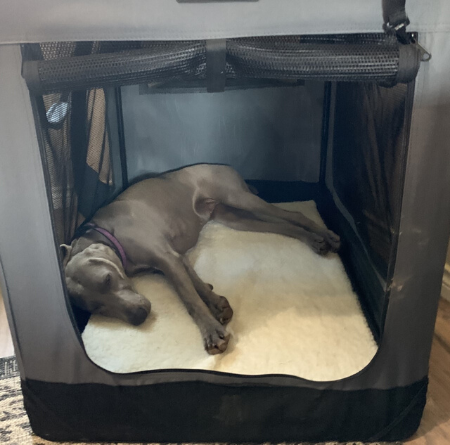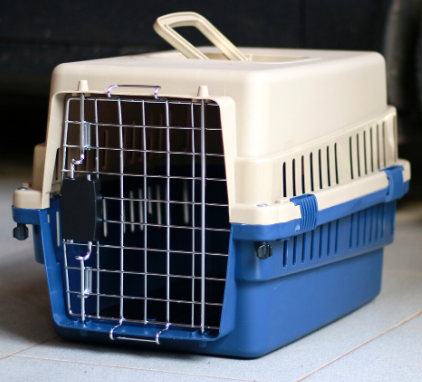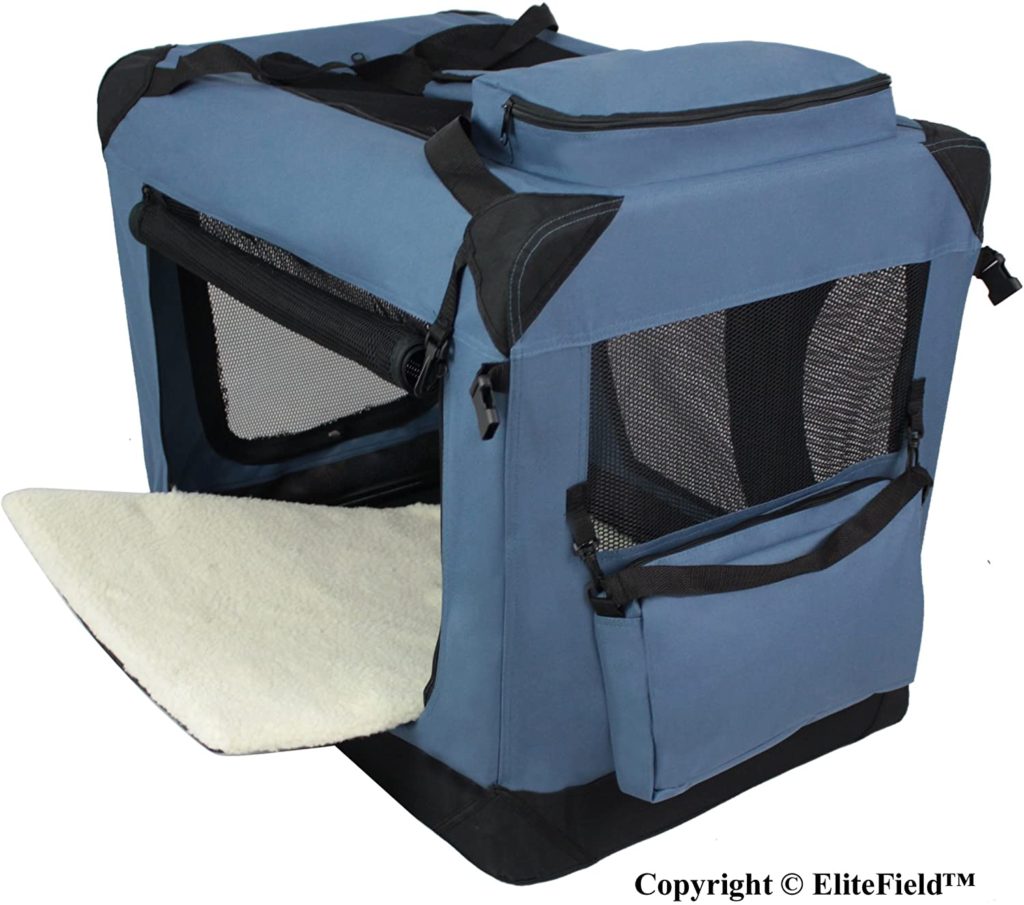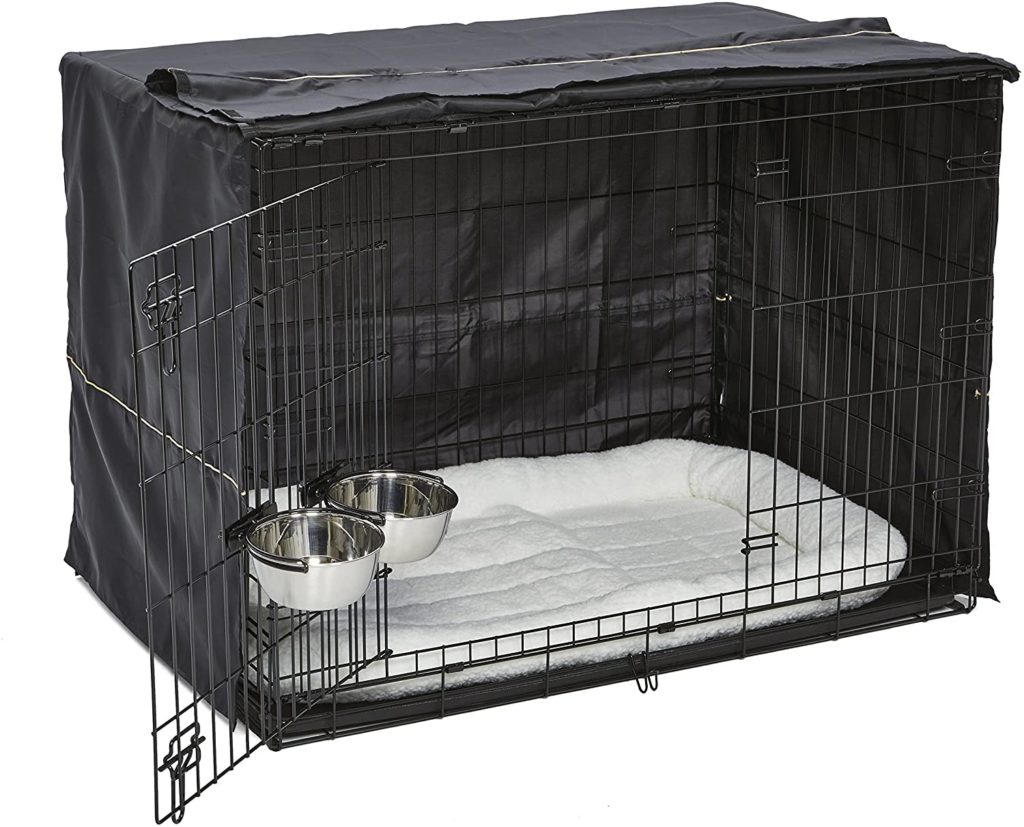You have decided to bring home a new Weimaraner puppy! Congratulations! A great adventure is about to begin. This is very exciting and also a huge responsibility. You are in charge of teaching this fuzzy gray bundle of cuteness how to become a well mannered loyal companion. Where do you start?
Crate training is one of the most important parts of a Weimaraner’s training and should be one of the first things they learn. Crate training keeps a Weimaraner safe, deters destructive behavior, helps prevent potty accidents and teaches independence. Crate training also provides a Weimaraner with a comfortable place to retreat to when he wants to rest.
Puppies are used to being with their mom and litter mates all of the time. The first few days in a new home without siblings will be a big adjustment for your Weimaraner puppy. Crate training will help make this transition easier for both you and your new furry friend. Here are a few crate training tips I have learned from having Weimaraners over the past 30 years.
Early Crate Training

The first thing I recommend doing when getting a new puppy is to set up its crate. Your crate should be put in a quiet area like a laundry room, spare bedroom or a corner in your living room. Put it somewhere that you want your dog to frequent as this will eventually become his safe place. I do not recommend putting the crate in your bedroom as this will make learning independence much more difficult. More on that later.
The crate for your Weimaraner puppy should only be big enough for him to stand up and turn around in easily. If your crate is too big your puppy might be tempted to use the bathroom in it which can make potty training take longer. Most large wire crates come with a divider panel that can be moved as the puppy grows. This saves on having to buy multiple crates as Weimaraner puppies grow quickly.
Crate training should start the first day you bring your Weimaraner puppy home. The first few days will be challenging since being alone is something new to your puppy. He will naturally want to be with you all of the time. Don’t give in to his sad puppy dog eyes no matter how hard it is. Being consistent with this especially the first few days will make the whole crate training process much easier on both of you.
The puppy should sleep in his crate from the first night home with you. Young puppies may need to use the bathroom during the night for the first few weeks. Take him outside, praise him for using the bathroom and then put him back in the crate to sleep for the rest of the night. It is important that the puppy not view this time out of the crate as play time. Your puppy is sure to protest, sometimes very loudly, the first few nights in the crate. He is safe in there and will learn fastest if you do not go to him and try to comfort him. Let him figure out that he will be fine on his own.

During the day a puppy should be put in his crate whenever you cannot watch him fully and at rest times. Puppies can chew cords or small items which can be very dangerous or even deadly. They also like to chew on things like furniture and shoes. The crate is important for keeping your puppy, your furniture and personal belongings safe.
I keep a few safe toys in my puppy’s crate to keep him occupied when he is awake and I can’t supervise him. I also have a soft bed or blanket in there for him to sleep on. The crate will quickly become one of your puppy’s favorite places and he will choose to go into it on his own when he gets tired if the door is left open. I also cover the top of my wire crates with a blanket so it feels more den-like for my puppies, leaving the front open so he can see out easily.
Crate Training and Potty Training
Many people confuse crate training and potty training or house breaking. They assume that crate training is also potty training the puppy. This is not the case. A crate trained dog is not necessarily house trained. While it is true that a puppy or dog will usually not use the bathroom in a properly sized crate, this does not mean that the dog won’t use the bathroom in the house. Crate training and potty training are two separate things that must be taught independently.
Crate training definitely can be a helpful tool when house breaking or potty training your Weimaraner. A puppy will try its best to avoid using the bathroom inside the crate. You can use this to your advantage when scheduling your puppy’s day. Be careful though because spending too much time in the crate can actually delay house breaking.
When house breaking your Weimaraner, it is important to make sure he is spending a good amount of time loose in the house and going outside frequently to use the bathroom. Doing this over and over teaches your puppy to not eliminate inside the house. If your puppy spends most of his time in a crate and then is let outside to potty, he will learn not to use the bathroom in a crate. I wrote another article that discusses the house breaking process in detail HERE.
Learning Independence
One of the more important things that crate training teaches a Weimaraner is independence. Weimaraners need to learn how to be alone. These dogs get very attached to their owners and prefer to be by their sides at all times. This is simply not possible in most households. Learning that it is ok to be alone is important for this breed to prevent certain behavior problems.
The strong bond that Weimaraners form with their people can cause very real stress to the dog in their absence. This is called separation anxiety. A Weimaraner that has not been properly socialized to spending time by himself can suffer severe separation anxiety at times which can make him very destructive. Luckily this very stressful condition can be avoided.
Crate training your puppy and making it spend time by itself every day will help to prevent separation anxiety from ever developing. Doing this will make things much easier on both you and your Weimaraner when you cannot be together. This training is definitely time well spent to the benefit of you both.
A helpful tip is to make sure you are frequently giving your Weimaraner time alone in his crate when you are still at home. Some people make the mistake of only putting their Weimaraner in a crate when they leave. Being without their people is hard on a Weimaraner. It won’t take long for this smart breed to associate the crate as something bad if he is only put in there when his people are going to be away. Crating a Weimaraner only when leaving the house could actually make separation anxiety worse. A Weimaraner needs to learn his crate is a good place to be and must not associate it with stressful events.
Different Types of Crates
This post contains affiliate links, which means I receive a small commission, at NO extra cost to you, if you make a purchase using this link. Buying an item through these links helps me to continue to provide quality content at no cost to my readers. I ONLY link to products that I have used myself and recommend.
Choosing the right crate for your Weimaraner can be confusing at first. With so many different types of crates available, which one is right for your Weimaraner? The good news is there really isn’t a wrong answer to this question. Most crate types will usually work fine for a Weimaraner. Each style of crate has its own advantages and disadvantages. Choose one that fits your lifestyle best.
Soft Crates
Soft crates are lightweight, foldable crates that are easy to move around. They are usually made of canvas, have a mesh zipper door, mesh zipper top and mesh windows. This is the only crate that is NOT suitable for crate training or crating a crate trained Weimaraner unless you are there to supervise at all times. These crates do not contain an unsupervised dog or puppy safely. A dog or puppy can easily rip through the sides or door of a soft crate. I have soft crates and use them only when I am bringing one dog with me to a competition such as a Scent Work trial. I also use them left open in my home after my dogs get older and I no longer crate them regularly. They seem to love the comfort and security of the soft crates and go in them frequently for naps. This is the soft crate that I have.
Wire Crates
Wire crates are foldable and are usually not too heavy. They are almost flat when they are folded down and are a favorite of people that show or compete with their dogs since they are portable. Wire crates are available in many sizes and the larger ones usually come with an extra panel to make the crate smaller inside for puppies. I personally use wire crates when crate training my Weimaraners. I usually cover the top and 2 sides of my wire crates with a blanket to make them feel more den like for my dogs. Be sure to buy a fairly sturdy crate as some cheaper wire crates are too flimsy for a dog that may try to escape. This is a nice wire crate starter kit available on Amazon that I recommend.
Plastic Crates

Molded plastic crates are another good choice for crate training Weimaraners. These crates are usually light weight and sturdy. They can be easily cleaned and feel den-like. The downside to this type of crate is they can get chewed and they are a bit bulky to move from place to place easily, such as dog shows. Molded plastic crates are usually airline approved, just make sure to check the airline requirements before purchasing one for this purpose.
Final Thought
Crate training is an important part of your Weimaraner’s total training. It may seem difficult at first. Remember to be firm and consistent with your puppy and he will be crate trained in no time!



